
Historic moment
Here we see history in the making.... the first American plane to land on Guadalcanal touches down on the airstrip only recently taken from the Japanese; August 12, 1942. See the following picture for a close-up.

Historic moment
Here we see history in the making.... the first American plane
to land on Guadalcanal touches down on the airstrip only recently taken from the Japanese;
August 12, 1942. See the following picture for a close-up.
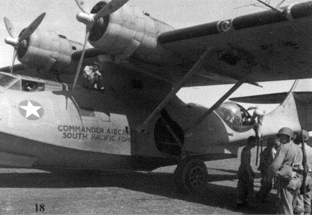
Errand of Mercy
The first aircraft to land on Guadalcanal after the Americans
took control of the airfield was this PBY-5A Catalina flying boat flown by William S.
Sampson, aide to Vice Admiral John S. McCain. It took off later that day with a load of
wounded Marines.
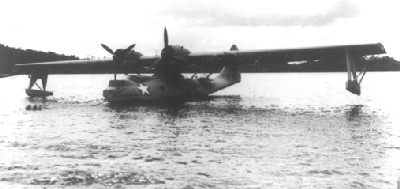
Offshore Cat
This PBY-5A is anchored to its mooring bouy just offshore of
Guadalcanal.
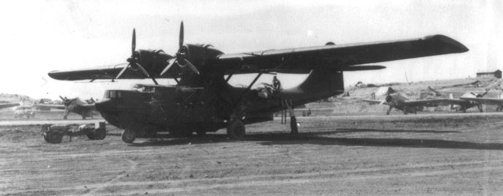
Navy PBY Catalina
sits on Henderson Field, with several U.S. Marine TBF Avenger
torpedo bombers in the background.

Jungle camoflage
A B-17 bomber hides under camoflage netting in the jungle near
Henderson Field.
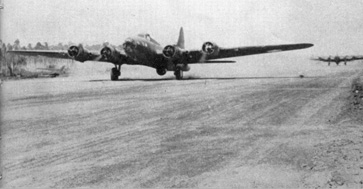
The thunder of four Wright Cyclone engines
Flying Fortresses take off from Henderson Field.
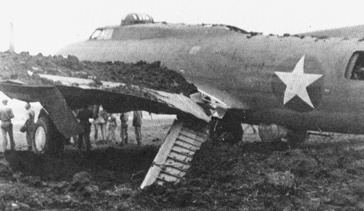
Caught on the ground at Henderson Field
During the heavy Japanese shelling on the night of 13 October
1942, several B-17s of the 11th Bombardment Group were so damaged that they could not
depart with the others for Espiritu Santo. A shell bursting under the wing of this plane
sent shell fragments through the fuselage and left wing. The explosion tore off a flap and
covered the airplane with clods of earth.
(Source: "Guadalcanal - The Island of
Fire" by Robert Lawrence Ferguson)
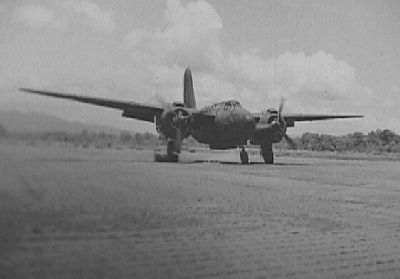
Daytime arrival of a night fighter
A P-70 Nighthawk (night fighter version of the A-20) of
the 6th Night Fighter Squadron taxis on the Marston matting of Henderson Field.
Five P-70s arrived in November 1942, hoping to score against the nighttime nuisance
Japanese bombers. Unfortunately, nighttime interceptions using the primitive radar sets at
that time were a rare occurrence, partly due to the time needed for the P-70 to get to
altitude, and partly due to the infancy of the new radar technology. Only two kills were
made by P-70s in the Pacific war, neither of which were over Guadalcanal. Most of the 6th
Night Fighter Squadron pilots went on to fly P-38s, while the P-70s were eventually
superceded by the P-61 Black Widow later in the war.
(Source: Ralph G. Tuttle)
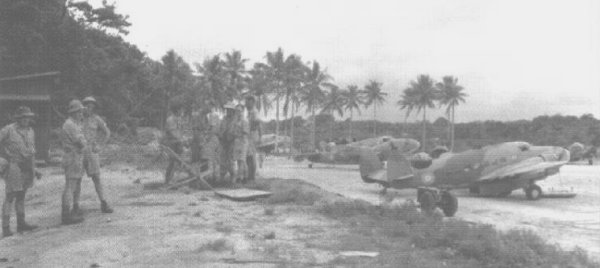
Royal New Zealand Air Force No 3 Squadron arrives at Henderson Field
A flight of RNZAF No 3 Squadron of Lockheed Hudson (PBO) reconnaissance bombers was
moved from Santos to Guadalcanal on 23 November 1942. The six aircraft and eight crews set
up camp in a jungle-clad gully close to Henderson Field. They were attached to the Air
Search and Attack Command, which formed part of Task Force 63. The Search and Patrol Group
conducted daily and nightly searches of the approaches to Guadalcanal, and daily low-level
searches along the coastlines of islands which might be used as staging-posts for enemy
movements of supplies and troops. Up till then American heavy bombers had been used for
reconnaissance, or dive and torpedo bombers. The dive bombers had to return to base and
bomb-up for strike missions, by which time the target often disappeared. The Hudsons had
machine guns for defence, and normally carried four 500-pound bombs. They were regarded as
lightly-armed sitting-ducks, and crews were told their job was to report enemy movements
not to go looking for trouble.
(Source: New Zealand
Defence "Defence Update" of July 2002, courtesy John Wilson of Wellington, New Zealand)
Click HERE if navigation menu is not visible on the left